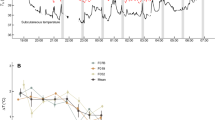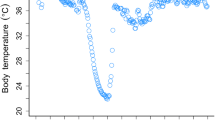Abstract
The circannual patterns in resting metabolic rate (RMR) of males of two subspecies of stonechats, the European Saxicola torquata rubicula and the East African S. t. axillaris, are compared. As the birds from the two subspecies were raised and kept under comparable laboratory conditions, differences in metabolic rate between the two subspecies had to be genetically determined. RMR peaked during moult in both subspecies. During the rest of the year RMR was fairly constant in both subspecies and assumed to reflect basal metabolic rate (BMR). African stonechats had a 22% lower mass specific BMR than European stonechats, which is thought to reflect a genetical physiological adaptation to the differences in environmental circumstances they experience in the field. A low BMR makes an animal more susceptible to cold. Hence, the relatively high plumage mass in the African compared to the European stonechat may be functionally linked to its relatively low BMR. Moult costs, calculated from the plumage masses and the differences in RMR inside and outside the moult period, tended to be higher in the European compared to the African stonechats. These data and an interspecific comparison of moult costs over various species of birds support the earlier notion by Lindström et al. (1993) that moult costs are more closely linked with BMR than with body mass or rate of moult. The relation between moult costs and BMR and the fact that the efficiency of moult is extremely low (3.8 and 6.4% for European and African stonechats, respectively) suggest that the maintenance of specific tissues necessary for moult is a large cost factor. Alternatively, impaired insulation during moult may necessitate an increased metabolic capacity which may be associated with an increased RMR.
Similar content being viewed by others
References
Aschoff J (1981) Thermal conductance in mammals and birds: its dependence on body size and circadian phase. Comp Biochem Physiol 69A: 611–619
Aschoff J, Pohl H (1970) Der Ruheumsatz von Vögeln als funktion der Tageszeit und der Körpergrösse. J Ornithol 111: 38–47
Baker JR (1938) The relation between latitude and breeding seasons in birds. Proc Zool Soc Lond 108: 557–582
Berthold P, Gwinner E, Klein H (1970) Verglcichende Untersuchung der Jugendentwicklung eines geprägten Zugvogels (Sylvia borin) und eines weniger ausgeprägten Zugvogels (S. atricapilla). Vogelwarte 25: 297–331
Biebach H (1975) Seasonal differences in resting metabolic rate of Turdus merula. Naturwissenschaften 62: 398
Blackmore FH (1969) The effect of temperature, photoperiod and molt on the energy requirements of the house sparrow, Passer domesticus. Comp Biochem Physiol 30: 433–444
Brown CR, Adams NJ (1988) Egg temperature, embryonic metabolism, and water loss from the eggs of subantarctic procellariiformes. Physiol Zool 61: 126–136
Bryant DM, Hails CJ (1983) Energetics and growth of three tropical bird species. Auk 100: 425–439
Chilgren JD (1978) Effects of photoperiod and temperature on postnuptial molt in captive white-crowned sparrows. Condor 80: 222–229
Daan S, Masman D, Strijkstra A, Verhulst S (1989) Intraspecific allometry of basal metabolic rate: relations with body size, temperature, composition and circadian phase in the kestrel, Falco tinnunculus. J Biol Rhythms 4: 267–284
Daan S, Masman D, Groenewold A (1990) Avian basal metabolic rates: their association with body composition and energy expenditure in nature. Am J Physiol 259: R333-R340
Dawson WR, Carey C (1976). Seasonal acclimatization to temperature in cardueline finches. I. Insulative and metabolic adjustments. J Comp Physiol 112: 317–333
Dawson WR, Marsh RL, Yacoe ME (1983) Metabolic adjustments of small passerine birds for migration and cold. Am J Physiol 245: R755-R767
Dietz MW, Daan S, Masman D (1992) Energy requirements for molt in the kestrel, Falco tinnunculus. Physiol Zool 65: 1217–1235
Dolnik VR,(1965) Bioenergetics of molt of finches as adaptations to migration (in Russian). Noy Ornithol 4: 124–126
Dolnik VR, Gavrilov VM (1975) A comparison of the seasonal and daily variations in bioenergetics, locomotor activities and major body composition in the sedentary house sparrow [Passer d. domesticus (L.)] and the migratory “Hindian” sparrow (P. d. bactrianus Zar. et Kudasch.). Ekol Pol 23: 211–226
Dolnik VR, Gavrilov VM (1979) Bioenergetics of molt in the chaffinch (Fringilla coelebs). Auk 96: 253–264
Drent RH, Daan S (1980) The prudent parent: energetic adjustments in avian breeding. Ardea 68: 225–252
Drent R, Klaassen M (1989) Energetics of avian growth: the causal link with bmr and metabolic scope. In: Bech C, Reinertsen RE (eds) Physiology of cold adaptation in birds. Plenum Press, New York, pp 349–359
Ellis HI (1984) Energetics of free-ranging seabirds. In: Whittow GC, Rahn H (eds) Seabird energetics. Plenum Press, New York, pp 203–234
Ginn HB, Melville DS (1983) Moult in birds. British Trust for Ornithology Guide 19, Tring, England
Grubb TC Jr (1989) Ptilochonology: feather growth bars as indicators of nutritional status. Auk 106: 314–320
Gwinner E, Dittami J (1990) Endogenous reproductive rhythms in a tropical bird. Science 249: 906–908
Gwinner E, Berthold P, Klein H (1971) Untersuchungen zur Jahresperiodik von Laubsängern. II. Einfluß der Tageslichtdauer auf die Entwicklung des Gefieders, des Gewichts und der Zugunruhe bei Phyloscopus trochilus und Ph. collybita. J Ornithol 112: 253–265
Gwinner E, Dittami J, Gwinner H (1983) Postjuvenile molt in east African and central European stonechats (Saxicola torquata axillaris, S. t. rubicula) and its modification by photoperiod. Oecologia 60: 66–70
Gwinner E, Neusser V, Schmidl D, Bals L (1987) Haltung, Zucht und Eiaufzucht afrikanischer und europäischer Schwarzkelchen (Saxicola torquata). Gefiederte Welt 5/6: 118–120, 145–147
Hails CJ (1983) The metabolic rate of tropical birds. Condor 85: 61–65
Hill RW (1972) Determination of oxygen consumption by use of the paramagnetic oxygen analysei. J Appl Physiol 33: 261–263
Hudson JW, Kimzey SL (1966) Temperature regulation and metabolic rhythms in populations of the house sparrow, Passer domesticus. Comp Biochem Physiol 17: 203–217
Jenni L, Winkler R (1994) Moult and aging of European passerines. Academic Press, London
Kersten M, Piersma T (1987) High levels of energy expenditure in shorebirds: metabolic adaptations to an energetically expensive way of life. Ardea 75: 175–187
King JR (1980) Energetics of avian moult. In: Nöhring R (ed) Acta XVII Congressus Internationalis Ornithologici. Verlag der Deutschen Ornithologen Gesellschaft, Berlin, pp 312–317
Kirkwood JK, Prescott NJ (1984) Growth and pattern of gut development in mammals and birds. Livest Prod Sci 11: 461–474
Klaassen M (1994) Growth and energetics of tern chicks from temperate and polar environments. Auk 111: 525–544
Klaassen M, Biebach H (1994) Energetics of fattening and starvation in the long-distance migratory garden warbler, Sylvia borin, during the migratory phase. J Comp Physiol B 164: 362–371
Klaassen M, Drent R (1991) An analysis of hatchling resting metabolism: in search of ecological correlates that explain deviations from allometric relations. Condor 93: 612–629
Klaassen M, Bech C, Masman D, Slagsvold G (1989a) Energy partitioning in arctic tern chicks (Sterna paradisaea) and possible metabolic adaptations in high latitude chicks. In: Bech C, Reinertsen RE (eds) Physiology of cold adaptation in birds, Plenum Press, New York, pp 339–347
Klaassen M, Bech C, Masman D, Slagsvold G (1989b) Growth and energetics of arctic tern chicks (Sterna paradisaea). Auk 106: 240–248
Konarzewski M (1995) Allocation of energy to growth and respiration in avian postembryonic development. Ecology 76: 8–19
Koong LJ, Ferrell CL, Nienaber JA (1982) Effects of plane of nutrition on organ size and fasting heat production in swine and sheep. In: Ehern A, Sundstøl F (eds) European association for animal production (EAAP) publication 29, Agricultural University of Norway, pp 245–248
Lindström Å, Visser GH, Daan S (1993) The energetic cost of feather synthesis is proportional to basal metabolic rate. Physiol Zool 66: 490–510
Murphy ME, King JR (1982) Amino acid composition of the plumage of the white-crowned sparrow. Condor 84: 435–438
Murphy ME, King JR (1984) Sulfur amino acid nutrition during molt in the white-crowned sparrow. I. Does dietary amino acid concentration affect the energetics of molt as assayed by metabolized energy? Condor 86: 314–323
Murphy ME, King JR (1986) Diurnal constancy of feather growth rates in white-crowned sparrows exposed to various photoperiods and feeding schedules during the post-nuptial molt. Can J Zool 64: 1292–1294
Murphy ME, King JR (1990) Diurnal changes in tissue gluthathione and protein pools of molting white-crowned sparrows: the influence of photoperiod and feeding schedules. Physiol Zool 63: 1118–1140
Murphy ME, King JR (1991) Nutritional aspects of avian molt. In: Bell BD (ed) Acta XX Congressus Internationalis Ornithologici. New Zealand Ornithological Congress Trust Board, Wellington, pp 2186–2193
Murphy ME, King JR (1992) Energy and nutrient use during moult by white-crowned sparrows Zonotrichia leucophrys gambelii. Ornis Scand 23: 304–313
Murphy ME, Taruscio TG, King JR, Truitt SG (1992) Do molting birds renovate their skeletons as well as their plumages? Osteoporosis during the annual molt in sparrows. Can J Zool 70: 1109–1113
Piersma T (1994) Close to the edge: energetic bottlenecks and the evolution of migratory pathways in knots. Het Open Boek, Den Burg, The Netherlands
Pohl H (1970) Zur Wirkung des Lichtes auf die circadiane Periodik des Stoffwechsels und der Aktivität beim Buchfinken (Fringilla coelebs L.). Z Vergl Physiol 66: 141–163
Pohl H, West GC (1973) Daily and seasonal variation in metabolic response to cold during rest and forced exercise in the common redpoll. Comp Biochem Physiol 45A: 851–867
Rahn H, Whittow GC (1984) Introduction. In: Whittow GC, Rahn H (eds) Seabird energetics. Plenum Press, New York, pp 1–32
Reeds PJ (1991) The energy cost of protein deposition. In: Wenk C, Boessinger M (eds) Energy metabolism of farm animals. European association for animal production (EAAP) publication 58, pp 473–479
Ricklefs RE (1976) Growth rates of birds in the humid new world tropics. Ibis 118: 179–207
Rising JD, Hudson JW (1974) Seasonal variation in the metabolism and thyroid activity of the black-capped chickadee (Parus atricapillus). Condor 76: 198–203
Swanson DL (1991) Seasonal adjustments in metabolism and insulation in the dark-eyed junco. Condor 93: 538–545
Taylor JRE (1985) Ontogeny of thermoregulation and energy metabolism in pygoscelid penguin chicks. J Comp Physiol 155B: 615–627
Thiollay J-M (1991) Food limitation in tropical bird populations. In: Bell BD (ed) Acta XX Congressus Internationalis Ornithologici. New Zealand Ornithological Congress Trust Board, Wellington, pp 1576–1583
Turcek FJ (1966) On plumage quantity in birds. Ekologia Pol 14A: 617–634
Warkentin IA, West NH (1990) Ecological energetics of wintering merlins Falco columbarius. Physiol Zool 63: 308–333
Weathers WW (1979) Climatic adaptations in avian standard metabolic rate. Oecologia 42: 81–89
Weathers WW, Caccamise DF (1978) Seasonal acclimatization to temperature in monk parakeets. Oecologia 35: 173–183
Wijnandts H (1984) Ecological energetics of the long-eared owl (Asio otus). Ardea 72: 1–92
Author information
Authors and Affiliations
Rights and permissions
About this article
Cite this article
Klaassen, M. Moult and basal metabolic costs in males of two subspecies of stonechats: the European Saxicola torquata rubicula and the East African S. t. axillaris . Oecologia 104, 424–432 (1995). https://doi.org/10.1007/BF00341339
Received:
Accepted:
Issue Date:
DOI: https://doi.org/10.1007/BF00341339




